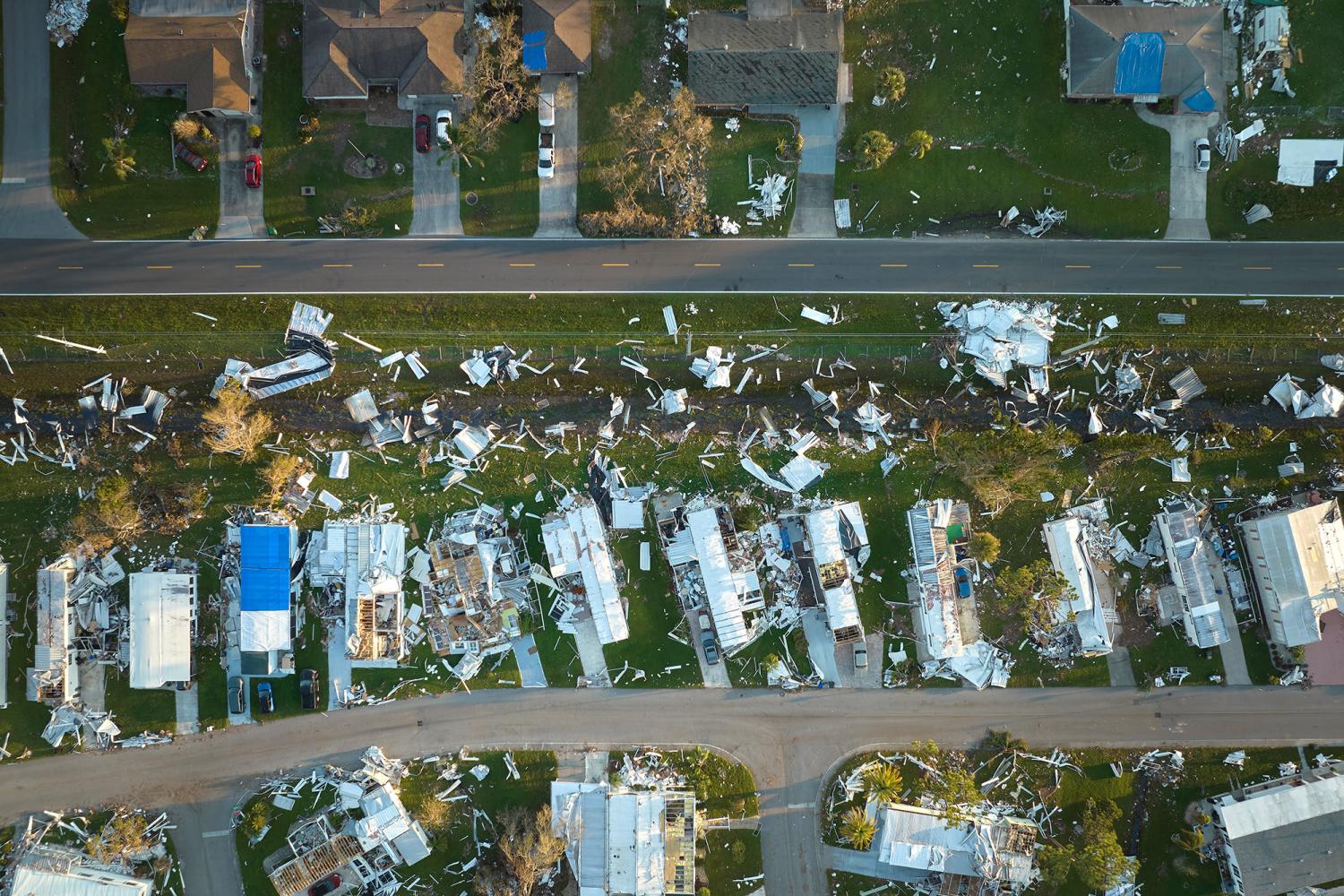This is the first post in a series on reforming national disaster policy. This post outlines principles for reform, while the next in the series focuses on changes to the federal disaster declaration process.
This November marks the 35th anniversary of the signing of the Robert T. Stafford Disaster Relief and Emergency Assistance Act—the statute that enables the federal government to assist states and their residents after emergencies and major disasters. The act is the foundation for our national disaster policy, but its anniversary comes with some clouds overhead.
In the years since the Stafford Act’s passage, we have entered a new, quickening pace of natural disasters. Witness the hurricanes Katrina, Harvey, and Maria; Superstorm Sandy; and the Camp, Mendocino, Dixie, and August fires. The devastation these events caused mobilized our federal disaster system, but there have also been thousands of smaller yet just as personally devastating events that failed to garner national resources. In the last year alone, the federal government authorized 16 times as many presidential emergency declarations as in 1988, when the Stafford Act became law and the costs of damages were much lower on average.
Across all these cases, human suffering and irrecoverable damages fall through the cracks in the system. And there are many cracks; long-standing inequities such as racism and income disparities often translate into different rates of disaster assistance and vastly divergent outcomes.
Federal disaster responses do not fully prevent this pain. The focus on the trauma and heroism of relief and response obscures the benefits that can come from better shared preparedness in our neighborhoods and the physical mitigation of damages to our possessions, communities, and infrastructure.
Finally, the increasing frequency and magnitude of these disasters mean that federal assistance has also become unsustainable operationally. Federal coffers are tapped daily, government staff are burnt out, and communities are raised and rebuilt at a thoughtless pace. The system needs to be fixed.
As risk grows, major questions arise about why, when, and how the federal government intervenes. Thirty-five years after the Stafford Act, our current federal disaster system—stressed by climate change and continued development in high-risk areas—demands reform.
To that end, researchers at Brookings are introducing a series of briefs that seek to integrate ethical and operational principles into the key debates at the core of our federal disaster policy inertia. The goal is to get policymakers to speak to each other, find common ground on our national objectives, and get going on the critical work of policy reform. In this introductory piece, we define the four principles that we believe should be driving any disaster policy and program reform: equity, efficiency, effectiveness, and environmental value.
Explicit focus on equity in federal aid can reduce pre-disaster vulnerabilities and post-disaster disparities
Research has shown that low-income households and communities that face burdens such as racism, disinvestment in infrastructure and public works, and cumulative environmental injustices suffer disproportionately from disasters. These disasters can be tipping points for families and individuals on the edge, pushing the marginally homeless into homelessness, and those living paycheck-to-paycheck into debt and financial insecurity. Yet our current disaster safety net contains too many holes—enough for the most vulnerable of our neighbors to slip through.
There have been many calls for disaster justice, often as a critical component of environmental, climate, and housing justice. Attention to this topic has been fueled by media coverage and recent scholarship documenting inequitable recoveries and the challenges that many lower-income households, households of color, rural and tribal communities, and physically challenged individuals face in the recovery process. These efforts are identifying access gaps and the unequal distribution of federal disaster resources at all stages. Further, the ability of those federal resources to reduce disparities in health, wealth, housing, and other life and livelihood outcomes is poorly documented. In some cases, instead of improving these metrics, inequitable access to disaster aid worsens pre-existing disparities.
We define “equity” as the fair distribution of resources—and fair participation in that distribution—before, during, and after a disaster based on need and vulnerability. There are several dimensions to our equity principle:
- Appropriate distribution of resources: The identification of demographic groups in disaster-affected areas is an essential step toward measuring differences in service and resource provision. Communities that have suffered from racism, persistent income disparities, and local public infrastructure underinvestment are often shortchanged and rarely prioritized. Current federal policy overlooks many pre-existing vulnerabilities and needs by ignoring basic demographic information about survivors—ultimately focusing attention and resources based on property values rather than people.
- Fair access: Accessing and understanding federal resources and programs can be challenging for those with constrained resources and other pressing life priorities before a disaster. After, most families are focused on basic survival and not complex applications and proof-of-need requirements for federal aid programs. Some communities, such as Native American tribes, have struggled even with being recognized by federal disaster agencies. All groups face access burdens from needless and repetitive bureaucracy, but certain households are especially challenged. Language, culture, educational attainment, immigration status, and geography can create an uneven field for accessing purportedly neutral, universal aid. Scrutinizing the methods and media for providing information and services to individuals reveals wide application and approval rate disparities.
- Inclusive participation: Procedural equity presumes that at-risk households and survivor communities participate in the planning and distribution of resources. Yet participation is often limited before a disaster strikes and is logistically complicated after. Given Congress’ established timeframes for services combined with federal agencies’ weak program rules for garnering public input on documents such as state hazard mitigation plans, inclusion is constrained from the outset. Representation matters, and reserving more seats at the table through active community engagement will help to ensure disaster management delivers for everyone.
- Diversity in recovery institutions: Equity also extends beyond identification and procedural concerns, including ensuring that populations from potentially disadvantaged groups are proportionally represented or overrepresented in a disaster recovery effort’s management, staff, and contractor and consultant pools.
- Accounting for historical inequities: Our current federal disaster policy does not account for historical social and economic disinvestments, or even disparities from past disasters. Instead, we need to rectify the economic and social legacies and trauma from multiple and intergenerational hazards. Too often, disaster policy wants to rebuild what was, even if that might not have been good for anybody.
A comprehensive reform of disaster policy should anticipate and integrate equity across all these dimensions. By not grounding policy in this principle, we risk widening inequalities, making some more vulnerable to future disasters, and undermining all other public policy goals in the long term.
Efficiency is key to distributing disaster responsibilities and costs and minimizing bureaucracy
The principle of program efficiency is a practical one, involving streamlining the federal financial, human, and knowledge resources required to meet targeted outcomes. Our principle of efficiency is based on the classical definition of efficiency: Public investments are assessed based on the amount of social benefit they accrue at the lowest social cost. But it also goes well beyond that, considering the costs that fraud and moral hazards add to current and future federal disaster programs as well as the broader concept of good stewardship of the public commons.
Therefore, this principle also focuses on the most efficient distribution of the responsibilities and costs of preparing for disasters and recovering from them, across all key stakeholders from the federal government through state and local governments as well as private sector developers and insurers. Dimensions of this principle include:
- Efficient use of resources: Achieving the greatest total benefit at lowest cost in our use of public funds is critical to ensure that resources to support households and their housing are not wasted in bureaucracy or profit-seeking. Economists and policymakers often define efficiency by quantifying costs and benefits with the hope of identifying projects that maximize the net benefits. Yet estimating benefits and costs can be time-consuming and resource-intensive; it has also been criticized for failing to account for the equitable distribution of those costs and benefits. There is currently no clear assessment of costs per household across programs or of the value-addition for different stakeholders. Ultimately, the costs in money, time, and other operational constraints must be included in comprehensive reform.
- Disincentivizing moral hazards: Our efficiency principle includes concerns about “moral hazard,” or a lack of incentives to reduce or manage a risk when someone else is paying the cost. Moral hazards can lead to gaps in insurance coverage, less investment in risk reduction measures, and poor community planning. There is concern that the expectation of public assistance after a disaster can reduce the impetus for households to protect themselves from those disasters. This is especially true among communities and individuals with the knowledge and financial resources to act independent of federal intervention. Local governments are also subject to moral hazard, since they have many of their costs paid for through federal disaster aid dollars. In response, they may forego more environmentally appropriate land use decisions or fail to adopt stricter building codes.
- Promoting good stewardship: Related to these efficiency considerations are the costs and impacts of monitoring for fraud and other abuse in garnering assistance unfairly. It is unclear whether the resources and time exhausted to monitor individual- or household-level fraud are warranted given the modest savings from their detection. The possible scamming of federal assistance is largely mitigated by the Stafford Act’s duplication of benefits clauses. Inspector General audits and Government Accountability Office reports have noted that, while some individual fraud exists, it is rarely of a magnitude that crowds out needy beneficiaries. However, attempts to reduce fraud can end up excluding some households from the aid they deserve and can radically slow the process of aid dispersal. Fraud surveillance has created a higher bar for applications across all disaster programs—often unfairly, when it comes to particularly vulnerable populations. At the same time, program supervision largely ignores other sources of financial abuse that drain program resources. Fraud in the form of disaster assistance providers, contractors, private insurers, and consultants receives less attention, though these entities often charge hefty fees both because of the emergency conditions in which they work and because the going rates are expensive in these high-turnover professions.
Disaster response options must be monitored, evaluated, and deemed effective
The third principle of reform—effectiveness—separately considers whether policies, programs, and private actions actually achieve their objectives while taking into account unintended effects. This principle highlights that to evaluate our public programs, we need clear objectives. Yet national policymakers rarely do this for individual disasters or our overall disaster policies, making this metric challenging to evaluate or achieve. Dimensions of this principle include:
- Clarifying objectives: Local and national elected officials typically proclaim “we will rebuild” or “we will build back better” after a hazard event without specific and measurable goals for housing, livelihoods, local economies, ecosystems, or other indicators. Policy interventions should ensure that investments in disaster recovery go beyond typical repairs and look toward long-term community-building. Health, wealth, and community stability are all longer-term outcomes to which short-term assistance should contribute. Yet our policy focus has been solely on immediate rebuilding. Our effectiveness definition, then, overlaps with equity and efficiency principles in the sense that it seeks successful outcomes, but ones that are fair and delivered with minimal social costs.
- Mitigating unintended consequences: Our effectiveness principle goes one step further than simple success measures, and considers if policies that achieve their objectives come with other unintended negative effects. For example, investments in either infrastructure or household risk mitigation designed to lower overall risk levels could fail to achieve this aim by creating an inaccurate sense of security and an inappropriate set of responses by households and communities that result in higher long-term risk (a parallel to “climate maladaptation”). Early policy work around flooding termed this the “levee effect.” Additionally, wholesale buyouts and relocations could produce the intended stated objective—immediately reducing the number of households at risk of flooding—but lead to numerous other poor or unwanted effects, such as higher housing costs for relocated people or diminished social networks and community traditions.
- Promoting an evidence base: We often treat each new disaster as if no disasters came before it. Ultimately, that’s because we lack good evidence to determine what is effective. There is a daunting lack of consistent monitoring and evaluation of the health, housing, and financial outcomes for survivor households, though anecdotally, these outcomes are known to diminish severely in specific disaster events, particularly for people who were vulnerable beforehand. There are too many unanticipated long-term impacts that may determine whether the intervention was ultimately equitable. For example, a concentrated investment in home buyouts or community-level infrastructure could result in rising housing unaffordability, displacement, and gentrification. Yet these life outcomes are rarely measured and monitored, though their cumulative effect is a critical dimension of disaster policy.
More work must be done to measure disparate impacts between survivor groups and policies that produce the desired outcomes, which can then be supported and scaled.
Forward-thinking policy should foreground disasters’ effects on our environment and integrate environmental change into reforms
Environmental changes will affect disaster management, but disaster management also affects the local environment. Holding environmental value as a principle means bringing climate change adaptation into our reforms, but also looking at how “green” infrastructure and ecosystem services can be better integrated into disaster policy. Dimensions of this principle include:
- Addressing climate change: In the absence of a comprehensive adaptation strategy, disaster policy has become our nation’s de facto climate adaptation policy. Our disaster programs are now the main source of support for households and communities facing both increasing climate shocks (such as hurricanes and wildfires) and slower-onset stressors (such as sea-level rise). But the resources available for disaster recovery are not structured to enable households and communities to integrate adaptation and resilience into rebuilding. While steps have been taken to move more federal risk reduction dollars into pre-disaster change (such as through the Federal Emergency Management Agency’s Building Resilient Infrastructure and Communities program), too many federal resources only come after climate-related disasters have damaged houses and their occupants’ livelihoods. Climate adaptation planning and investments in public works, housing, social programs, and related interventions need to be addressed in the calm before the storm, not only during or immediately after it. There are some existing programs that do this, but they typically do not address the myriad of chronic effects from climate change in addition to the acute disasters.
- Disasters and ecosystems: Many natural systems can help lower the risks of disasters, such as wetlands mitigating flooding and ecological forestry reducing wildfire risk. These systems simultaneously provide a range of other environmental benefits (or “ecosystem services”), from habitats for diverse species to air and water purification to carbon sequestration. Disasters have also led to (or are even caused by) direct environmental hazards such as toxic releases or acute pollutants. Understanding the complex, place-based interplay between local ecosystems and human settlements and the ways that climate change is exacerbating what we know—and don’t know—about them should shape disaster programs in the future.
How future entries in this series explore disaster reforms
The next five pieces in this series will each take on one policy or program debate, present novel solutions for reform, and assess them against our original principles. We are conscious of the overlap and intersection between our principles. For example, increasing the urban tree canopy lowers ambient temperatures (effectiveness), does so in cost-effective ways (efficiency), and supports greater environmental benefits such as carbon sequestration and habitat provision (environmental value). Since lower-income neighborhoods often have substantially fewer trees and thus suffer more from heat and respiratory health impacts associated with poor air quality, prioritizing these communities would also satisfy our final principle (equity).
Each post will focus on one central debate about how to fix our broken disaster management policies, such as how we define a “disaster,” which government agencies should manage disaster responses, who bears the burden of paying for those actions, and how these burdens need to account for long-standing vulnerabilities in communities. These issues are all currently being debated among federal policymakers, but without guiding principles for their resolution.
Too often, policy debates in Washington exist independent of principled conversation. Conversely, statements of principle regarding an important public conversation are typically abstractions—platitudes devoid of the nitty gritty details that change individuals’ lives and livelihoods and are more likely to represent the loudest interests than the very principles espoused. We see this especially in disaster policy—a field that has historically received bipartisan support, but where current authorized and appropriated programs are in desperate need of comprehensive statutory reform. We believe our current system can be reformed, and introduce this series with that goal in mind.
-
Acknowledgements and disclosures
The research included in this report was made possible through funding by the Walmart Foundation. The findings, conclusions, and recommendations presented in this report are those of the authors alone, and do not necessarily reflect the opinions of the Walmart Foundation.







